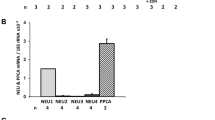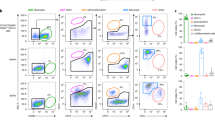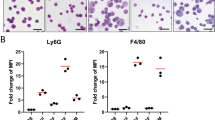Abstract
The glycan determinant CD15 (also known as Lewis x, or Lex) is a distinguishing marker for human myeloid cells and mediates neutrophil adhesion to dendritic cells. Despite broad interest in this structure, the mechanisms underlying CD15 expression remain relatively uncharacterized. Accordingly, we investigated the molecular basis of increasing CD15 expression associated with human myeloid cell differentiation. Flow cytometric analysis of differentiating cells together with biochemical studies using inhibitors of glycan synthesis and of sialidases showed that increased CD15 expression is not due to de novo biosynthesis of CD15, but results predominantly from induction of α(2-3)-sialidase activity, which yields CD15 from cell-surface sialyl-CD15 (also known as sialyl-Lewis x, sLex or CD15s). This differentiation-associated conversion of surface CD15s to CD15 occurs mainly on glycoproteins. Until now, modulation of post-translational glycan modifications has been attributed solely to dynamic variations in glycosyltransferase expression. Our results unveil a new paradigm by demonstrating a critical role for post-Golgi membrane glycosidase activity in the 'biosynthesis' of a key glycan determinant.
This is a preview of subscription content, access via your institution
Access options
Subscribe to this journal
Receive 12 print issues and online access
$259.00 per year
only $21.58 per issue
Buy this article
- Purchase on Springer Link
- Instant access to full article PDF
Prices may be subject to local taxes which are calculated during checkout





Similar content being viewed by others
References
Gooi, H.C. et al. Marker of peripheral blood granulocytes and monocytes of man recognized by two monoclonal antibodies VEP8 and VEP9 involves the trisaccharide 3-fucosyl-N-acetyllactosamine. Eur. J. Immunol. 13, 306–312 (1983).
Tao, W. et al. Comparative proteomic analysis of human CD34+ stem/progenitor cells and mature CD15+ myeloid cells. Stem Cells 22, 1003–1014 (2004).
Henderson, J.K. et al. Preimplantation human embryos and embryonic stem cells show comparable expression of stage-specific embryonic antigens. Stem Cells 20, 329–337 (2002).
Anjos-Afonso, F. & Bonnet, D. Nonhematopoietic/endothelial SSEA-1+ cells define the most primitive progenitors in the adult murine bone marrow mesenchymal compartment. Blood 109, 1298–1306 (2007).
Gege, C., Geyer, A. & Schmidt, R.R. Synthesis and molecular tumbling properties of sialyl Lewis X and derived neoglycolipids. Chemistry 8, 2454–2463 (2002).
Foxall, C. et al. The three members of the selectin receptor family recognize a common carbohydrate epitope, the sialyl Lewis(x) oligosaccharide. J. Cell Biol. 117, 895–902 (1992).
Dimitroff, C.J., Bernacki, R.J. & Sackstein, R. Glycosylation-dependent inhibition of cutaneous lymphocyte-associated antigen expression: implications in modulating lymphocyte migration to skin. Blood 101, 602–610 (2003).
Fuhlbrigge, R.C., Kieffer, J.D., Armerding, D. & Kupper, T.S. Cutaneous lymphocyte antigen is a specialized form of PSGL-1 expressed on skin-homing T cells. Nature 389, 978–981 (1997).
Sackstein, R. The bone marrow is akin to skin: HCELL and the biology of hematopoietic stem cell homing. J. Invest. Dermatol. 122, 1061–1069 (2004).
Sackstein, R. et al. Ex vivo glycan engineering of CD44 programs human multipotent mesenchymal stromal cell trafficking to bone. Nat. Med. 14, 181–187 (2008).
Zannettino, A.C. et al. Primitive human hematopoietic progenitors adhere to P-selectin (CD62P). Blood 85, 3466–3477 (1995).
Terstappen, L.W., Buescher, S., Nguyen, M. & Reading, C. Differentiation and maturation of growth factor expanded human hematopoietic progenitors assessed by multidimensional flow cytometry. Leukemia 6, 1001–1010 (1992).
van Gisbergen, K.P., Ludwig, I.S., Geijtenbeek, T.B. & van Kooyk, Y. Interactions of DC-SIGN with Mac-1 and CEACAM1 regulate contact between dendritic cells and neutrophils. FEBS Lett. 579, 6159–6168 (2005).
van Gisbergen, K.P., Sanchez-Hernandez, M., Geijtenbeek, T.B. & van Kooyk, Y. Neutrophils mediate immune modulation of dendritic cells through glycosylation-dependent interactions between Mac-1 and DC-SIGN. J. Exp. Med. 201, 1281–1292 (2005).
Kannagi, R. Transcriptional regulation of expression of carbohydrate ligands for cell adhesion molecules in the selectin family. Adv. Exp. Med. Biol. 491, 267–278 (2001).
Lowe, J.B. Glycosylation in the control of selectin counter-receptor structure and function. Immunol. Rev. 186, 19–36 (2002).
Nakayama, F. et al. CD15 expression in mature granulocytes is determined by alpha 1,3-fucosyltransferase IX, but in promyelocytes and monocytes by alpha 1,3-fucosyltransferase IV. J. Biol. Chem. 276, 16100–16106 (2001).
Lund-Johansen, F. & Terstappen, L.W. Differential surface expression of cell adhesion molecules during granulocyte maturation. J. Leukoc. Biol. 54, 47–55 (1993).
Kansas, G.S., Muirhead, M.J. & Dailey, M.O. Expression of the CD11/CD18, leukocyte adhesion molecule 1, and CD44 adhesion molecules during normal myeloid and erythroid differentiation in humans. Blood 76, 2483–2492 (1990).
Charrad, R.S. et al. Effects of anti-CD44 monoclonal antibodies on differentiation and apoptosis of human myeloid leukemia cell lines. Blood 99, 290–299 (2002).
Gadhoum, Z. et al. The effect of anti-CD44 monoclonal antibodies on differentiation and proliferation of human acute myeloid leukemia cells. Leuk. Lymphoma 45, 1501–1510 (2004).
Li, F. et al. Post-translational modifications of recombinant P-selectin glycoprotein ligand-1 required for binding to P- and E-selectin. J. Biol. Chem. 271, 3255–3264 (1996).
Maemura, K. & Fukuda, M. Poly-N-acetyllactosaminyl O-glycans attached to leukosialin. The presence of sialyl Le(x) structures in O-glycans. J. Biol. Chem. 267, 24379–24386 (1992).
Fuhlbrigge, R.C., King, S.L., Sackstein, R. & Kupper, T.S. CD43 is a ligand for E-selectin on CLA+ human T cells. Blood 107, 1421–1426 (2006).
Fukushima, K. et al. Characterization of sialosylated Lewisx as a new tumor-associated antigen. Cancer Res. 44, 5279–5285 (1984).
Datta, A.K. & Paulson, J.C. Sialylmotifs of sialyltransferases. Indian J. Biochem. Biophys. 34, 157–165 (1997).
Woods, J.M. et al. 4-Guanidino-2,4-dideoxy-2,3-dehydro-N-acetylneuraminic acid is a highly effective inhibitor both of the sialidase (neuraminidase) and of growth of a wide range of influenza A and B viruses in vitro. Antimicrob. Agents Chemother. 37, 1473–1479 (1993).
Stamatos, N.M. et al. Differential expression of endogenous sialidases of human monocytes during cellular differentiation into macrophages. FEBS J. 272, 2545–2556 (2005).
Wang, P. et al. Induction of lysosomal and plasma membrane-bound sialidases in human T-cells via T-cell receptor. Biochem. J. 380, 425–433 (2004).
Azuma, Y., Taniguchi, A. & Matsumoto, K. Decrease in cell surface sialic acid in etoposide-treated Jurkat cells and the role of cell surface sialidase. Glycoconj. J. 17, 301–306 (2000).
Kopitz, J., Muhl, C., Ehemann, V., Lehmann, C. & Cantz, M. Effects of cell surface ganglioside sialidase inhibition on growth control and differentiation of human neuroblastoma cells. Eur. J. Cell Biol. 73, 1–9 (1997).
Monti, E. et al. Identification and expression of NEU3, a novel human sialidase associated to the plasma membrane. Biochem. J. 349, 343–351 (2000).
Pshezhetsky, A.V. & Ashmarina, M. Lysosomal multienzyme complex: biochemistry, genetics, and molecular pathophysiology. Prog. Nucleic Acid Res. Mol. Biol. 69, 81–114 (2001).
Stroud, M.R. et al. Myeloglycan, a series of E-selectin-binding polylactosaminolipids found in normal human leukocytes and myelocytic leukemia HL60 cells. Biochem. Biophys. Res. Commun. 209, 777–787 (1995).
Dagia, N.M. et al. G-CSF induces E-selectin ligand expression on human myeloid cells. Nat. Med. 12, 1185–1190 (2006).
Hirata, T. et al. P-Selectin glycoprotein ligand 1 (PSGL-1) is a physiological ligand for E-selectin in mediating T helper 1 lymphocyte migration. J. Exp. Med. 192, 1669–1676 (2000).
Levesque, J.P. et al. PSGL-1-mediated adhesion of human hematopoietic progenitors to P-selectin results in suppression of hematopoiesis. Immunity 11, 369–378 (1999).
Varki, N.M. & Varki, A. Diversity in cell surface sialic acid presentations: implications for biology and disease. Lab. Invest. 87, 851–857 (2007).
Cyopick, P. et al. Role of aberrant sialylation of chronic myeloid leukemia granulocytes on binding and signal transduction by chemotactic peptides and colony stimulating factors. Leuk. Lymphoma 11, 79–90 (1993).
Aldape, M.J., Bryant, A.E., Ma, Y. & Stevens, D.L. The leukemoid reaction in Clostridium sordellii infection: neuraminidase induction of promyelocytic cell proliferation. J. Infect. Dis. 195, 1838–1845 (2007).
Crocker, P.R. Siglecs: sialic-acid-binding immunoglobulin-like lectins in cell-cell interactions and signalling. Curr. Opin. Struct. Biol. 12, 609–615 (2002).
Nguyen, D.H., Ball, E.D. & Varki, A. Myeloid precursors and acute myeloid leukemia cells express multiple CD33-related Siglecs. Exp. Hematol. 34, 728–735 (2006).
Capela, A. & Temple, S. LeX is expressed by principle progenitor cells in the embryonic nervous system, is secreted into their environment and binds Wnt-1. Dev. Biol. 291, 300–313 (2006).
Da Silva, J.S., Hasegawa, T., Miyagi, T., Dotti, C.G. & Abad-Rodriguez, J. Asymmetric membrane ganglioside sialidase activity specifies axonal fate. Nat. Neurosci. 8, 606–615 (2005).
Acknowledgements
We are grateful to D. Floyd, S. Hamdan, C. Silvescu and C. Knoblauch for technical support, to J. Merzaban, N. Stamatos, C. Dimitroff and M. Burdick for helpful discussions of the manuscript, and to I. Galinsky, R. Stone, D. DeAngelo, M. Wadleigh and A. Sirulnik for assistance in procuring leukemia samples. This work was supported by US National Heart, Lung, and Blood Institute grant RO1 HL60528 (R.S.), US National Institute of Diabetes and Digestive and Kidney Diseases grant R21 DK075012 (R.S.) and the Team Jobie Leukemia Research fund (R.S.).
Author information
Authors and Affiliations
Contributions
S.Z.G. designed the research, performed the experiments, analyzed the data and wrote the paper. R.S. conceived the study, designed the research, analyzed the data, wrote the paper, provided funding for the research and supervised all experimentation.
Corresponding author
Supplementary information
Supplementary Text and Figures
Supplementary Figures 1–3, Supplementary Table 1 and Supplementary Methods (PDF 123 kb)
Rights and permissions
About this article
Cite this article
Gadhoum, S., Sackstein, R. CD15 expression in human myeloid cell differentiation is regulated by sialidase activity. Nat Chem Biol 4, 751–757 (2008). https://doi.org/10.1038/nchembio.116
Received:
Accepted:
Published:
Issue Date:
DOI: https://doi.org/10.1038/nchembio.116
This article is cited by
-
Altered sialidase expression in human myeloid cells undergoing apoptosis and differentiation
Scientific Reports (2022)
-
EphA receptors and ephrin-A ligands are upregulated by monocytic differentiation/maturation and promote cell adhesion and protrusion formation in HL60 monocytes
BMC Cell Biology (2017)
-
Human deficiencies of fucosylation and sialylation affecting selectin ligands
Seminars in Immunopathology (2012)
-
Lessons from the Embryonic Neural Stem Cell Niche for Neural Lineage Differentiation of Pluripotent Stem Cells
Stem Cell Reviews and Reports (2012)
-
Gene and microRNA analysis of neutrophils from patients with polycythemia vera and essential thrombocytosis: down-regulation of micro RNA-1 and -133a
Journal of Translational Medicine (2009)



